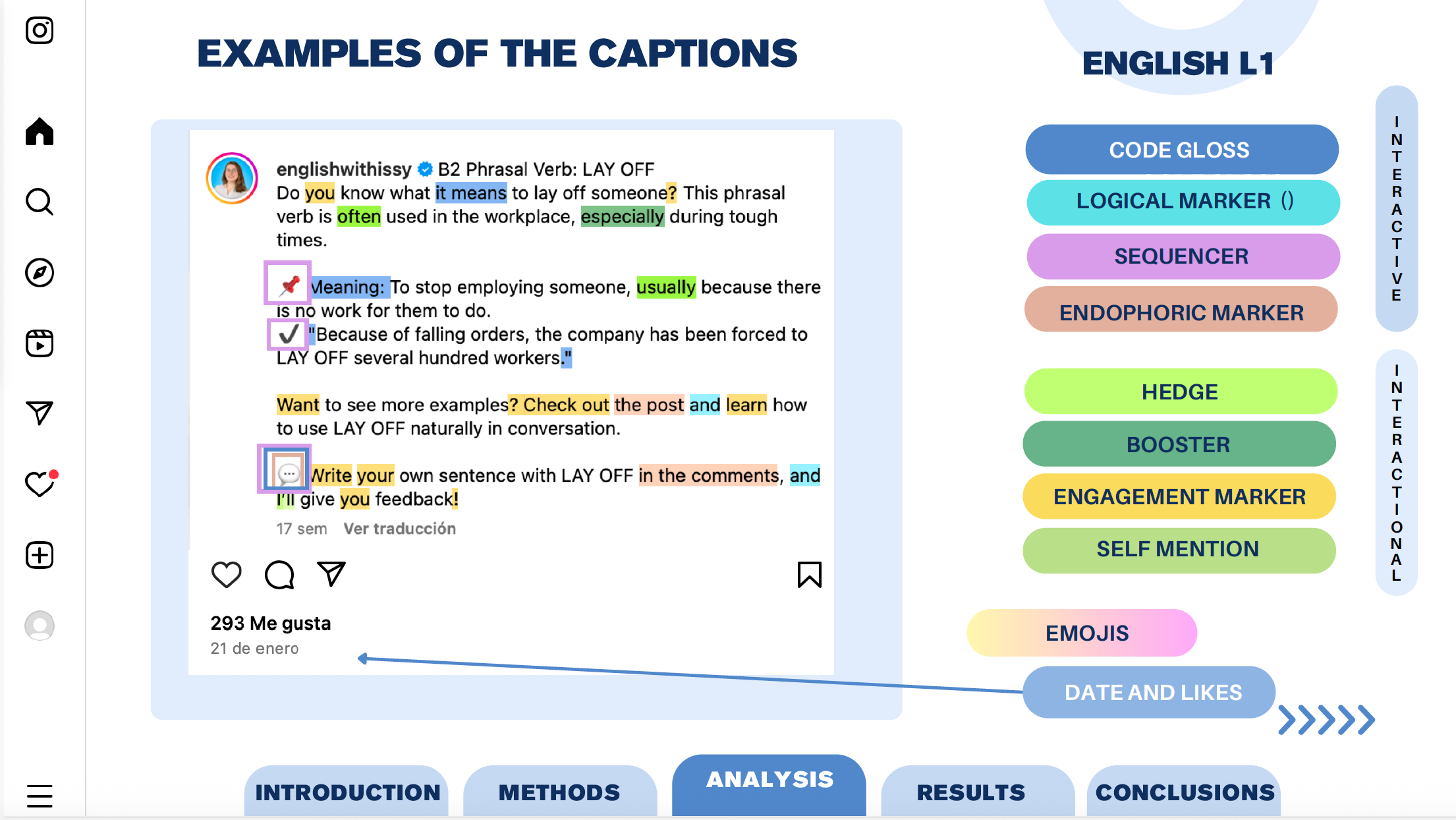AELFE 2025: LUCÍA LASHERAS LOOKS INTO ENGLISH PHRASEOLOGY ON INSTAGRAM POSTS

Lucía Lasheras-Bielsa participated in the 23rd edition of the International AELFE Conference 2025, which was centred on “Revisiting LSP in the multimodal literacy age”. It took place at the Universitat Jaume I over the span of three days, from Wednesday 25th to Friday 27th, in June 2025.
Her paper, entitled “Instagram as a multimodal platform for the recontextualization of English phraseology: Metadiscursive strategies in teaching English as a Second Language (ESL)”, focused on exploring the interactive and interactional strategies employed in the multimodal discourse of Instagram posts. To do so, she reported on the preliminary findings from a contrastive analysis of various posts from four English-speaking and Spanish-speaking sample accounts.
You can read more about her abstract below:
Instagram as a multimodal platform for the recontextualization of English phraseology: Metadiscursive strategies in teaching English as a Second Language (ESL)
In this era of fast-evolving technologies and globalization, English has become a key tool in many areas of communication worldwide. Digital genres have facilitated the recontextualization of knowledge shared with diversified audiences (Bondi & Cacchiani, 2021). Initially launched in 2010 as an entertainment source based on image-sharing,Instagram has evolved into a multimodal medium used for a wide variety of purposes, and the number of educational accounts is growing rapidly (Nasution, 2023). In this presentation I will focus on exploring the recontextualization of English phraseology (Stubbs, 2007; Dickins, 2020)—phrasal verbs, idioms, and collocations— on Instagram, a process whereby experts in the field of English as a Second Language (ESL) share grammatical and lexical knowledge. My corpus selection consists of four sample accounts, two English-speaking accounts and two Spanish-speaking ones. I aim to explore their similarities and differences through a contrastive qualitative and quantitative analysis of five posts per account. Thus, I examine the linguistic elements and metadiscourse features found in post captions, divided into two macro-categories, according to Hyland’s (2005) classification, and combined with the explanatory strategies proposed by Mur-Dueñas (2024). Interactive resources guide users through the text: code glosses and explanations, topicalisers, endophoric markers, etc. Interactional features include hedges, self-mentions, attitude and engagement markers, among others. I have also followed the adapted taxonomy provided by Mur-Dueñas & Pascual (2023), who explore metadiscoursive markers in academic tweets. The text in the Instagram post captions combined with emojis, images, videos, and overlay text helps provide a better understanding of the explained concepts. Furthermore, in the analysis, I take into account other indicators such as metrics and engagement rates, since features like comments, likes, and followers serve as makers of the users’ level of achieved engagement. The results obtained identify common patterns and practices that enhance effectiveness in the process.
References
Bondi, M. & Cacchiani, S. (2021). Knowledge communication and knowledge dissemination in a digital world. Journal of Pragmatics, 186, 117-123.
Dickins, J. (2020). An ontology for collocations, formulaic sequences, multiword expressions, compounds, phrasal verbs, idioms and proverbs. Linguistica Online, 23, 29-72.
Hyland, K. (2005). Metadiscourse: Exploring interaction in writing. Continuum
Mur-Dueñas, P., & Pascual, D. (2023). Metadiscoursal Realisation of Pragmatic Strategies@ ResearchProject Twitter Accounts. Atlantis. Journal of the Spanish Association for Anglo-American Studies, 119-150.
Mur-Dueñas, P. (2024). Digital dissemination practices: An analysis of explanatory strategies in the process of recontextualising specialised knowledge. Discourse and Interaction, 17(1), 94-114.
Nasution, A. K. P. (2023). Instagram in English Language Learning: A Systematic Literature Review. Journal of Linguistics, Literature, and Language Teaching (JLLLT), 3(1), 33-52.
Stubbs, M. (2007). An example of frequent English phraseology: distributions, structures and functions. En R. Facchinetti (Ed.), Corpus linguistics 25 years on (pp. 87-105). Brill.
